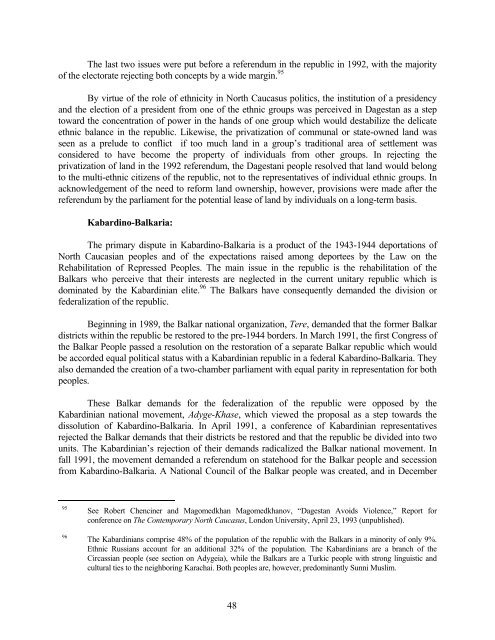RUSSIA'S TINDERBOX - Belfer Center for Science and International ...
RUSSIA'S TINDERBOX - Belfer Center for Science and International ...
RUSSIA'S TINDERBOX - Belfer Center for Science and International ...
Create successful ePaper yourself
Turn your PDF publications into a flip-book with our unique Google optimized e-Paper software.
The last two issues were put be<strong>for</strong>e a referendum in the republic in 1992, with the majority<br />
of the electorate rejecting both concepts by a wide margin. 95<br />
By virtue of the role of ethnicity in North Caucasus politics, the institution of a presidency<br />
<strong>and</strong> the election of a president from one of the ethnic groups was perceived in Dagestan as a step<br />
toward the concentration of power in the h<strong>and</strong>s of one group which would destabilize the delicate<br />
ethnic balance in the republic. Likewise, the privatization of communal or state-owned l<strong>and</strong> was<br />
seen as a prelude to conflict if too much l<strong>and</strong> in a group’s traditional area of settlement was<br />
considered to have become the property of individuals from other groups. In rejecting the<br />
privatization of l<strong>and</strong> in the 1992 referendum, the Dagestani people resolved that l<strong>and</strong> would belong<br />
to the multi-ethnic citizens of the republic, not to the representatives of individual ethnic groups. In<br />
acknowledgement of the need to re<strong>for</strong>m l<strong>and</strong> ownership, however, provisions were made after the<br />
referendum by the parliament <strong>for</strong> the potential lease of l<strong>and</strong> by individuals on a long-term basis.<br />
Kabardino-Balkaria:<br />
The primary dispute in Kabardino-Balkaria is a product of the 1943-1944 deportations of<br />
North Caucasian peoples <strong>and</strong> of the expectations raised among deportees by the Law on the<br />
Rehabilitation of Repressed Peoples. The main issue in the republic is the rehabilitation of the<br />
Balkars who perceive that their interests are neglected in the current unitary republic which is<br />
dominated by the Kabardinian elite. 96 The Balkars have consequently dem<strong>and</strong>ed the division or<br />
federalization of the republic.<br />
Beginning in 1989, the Balkar national organization, Tere, dem<strong>and</strong>ed that the <strong>for</strong>mer Balkar<br />
districts within the republic be restored to the pre-1944 borders. In March 1991, the first Congress of<br />
the Balkar People passed a resolution on the restoration of a separate Balkar republic which would<br />
be accorded equal political status with a Kabardinian republic in a federal Kabardino-Balkaria. They<br />
also dem<strong>and</strong>ed the creation of a two-chamber parliament with equal parity in representation <strong>for</strong> both<br />
peoples.<br />
These Balkar dem<strong>and</strong>s <strong>for</strong> the federalization of the republic were opposed by the<br />
Kabardinian national movement, Adyge-Khase, which viewed the proposal as a step towards the<br />
dissolution of Kabardino-Balkaria. In April 1991, a conference of Kabardinian representatives<br />
rejected the Balkar dem<strong>and</strong>s that their districts be restored <strong>and</strong> that the republic be divided into two<br />
units. The Kabardinian’s rejection of their dem<strong>and</strong>s radicalized the Balkar national movement. In<br />
fall 1991, the movement dem<strong>and</strong>ed a referendum on statehood <strong>for</strong> the Balkar people <strong>and</strong> secession<br />
from Kabardino-Balkaria. A National Council of the Balkar people was created, <strong>and</strong> in December<br />
95 See Robert Chenciner <strong>and</strong> Magomedkhan Magomedkhanov, “Dagestan Avoids Violence,” Report <strong>for</strong><br />
conference on The Contemporary North Caucasus, London University, April 23, 1993 (unpublished).<br />
96 The Kabardinians comprise 48% of the population of the republic with the Balkars in a minority of only 9%.<br />
Ethnic Russians account <strong>for</strong> an additional 32% of the population. The Kabardinians are a branch of the<br />
Circassian people (see section on Adygeia), while the Balkars are a Turkic people with strong linguistic <strong>and</strong><br />
cultural ties to the neighboring Karachai. Both peoples are, however, predominantly Sunni Muslim.<br />
48
















